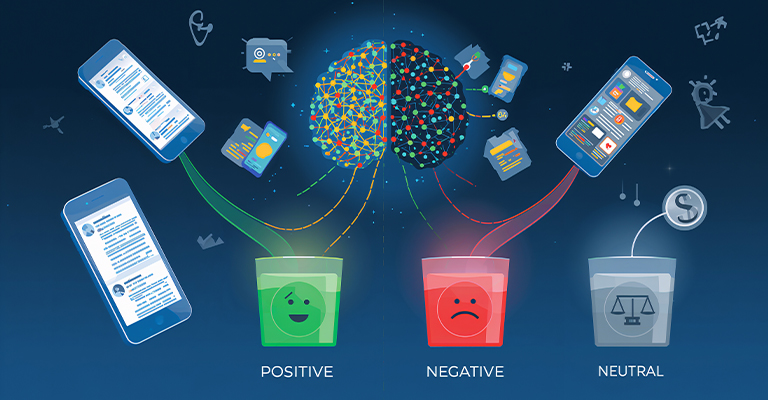Sentiment Analysis: Understanding Human Emotions Through AI
Sentiment analysis is a powerful application of AI technology. It teaches computers to read human emotions in text messages, reviews, and social media posts. Companies can then use this information to enhance customer satisfaction and make more informed business decisions.
In this post, you’ll learn how AI turns everyday words into emotion scores. We’ll look at easy methods that anyone can learn. We’ll also explore real examples of how people use sentiment analysis in their jobs and everyday life.
This guide introduces the basics of sentiment analysis. We’ll cover how computers learn, innovative AI methods, and how to build your own projects. By the end, you’ll know enough to create your own sentiment analysis tools.
Key Points
- What Is Sentiment Analysis?
- How Sentiment Analysis Works in Natural Language Processing
- Types of Sentiment Analysis Techniques
- Machine Learning Approaches
- Deep Learning Methods
- Real-World Applications
- Challenges and Limitations
- Sentiment Analysis Tools and Platforms
- Getting Started with Your First Project
- Final Thoughts on Sentiment Analysis
What Is Sentiment Analysis?

Sentiment analysis is a process where AI identifies emotions in written text. It essentially determines whether content is positive, negative, or neutral. Advanced systems can also detect specific emotions, such as happiness, anger, frustration, or excitement.
Think of sentiment analysis like teaching computers to read between the lines. When you read “This product completely changed my life for the better,” you immediately recognize the positive sentiment. Similarly, AI systems learn to identify these emotional patterns by training on thousands of labeled text examples.
This technology processes various text sources, including:
- Social media posts and comments
- Customer reviews and feedback
- Survey responses and questionnaires
- Email communications
- News articles and blog posts
However, the complexity of human language presents ongoing challenges for AI systems attempting to understand nuanced emotional expressions.
How Sentiment Analysis Works in Natural Language Processing
Natural language processing provides the foundation for sentiment analysis systems. First, computers break down text into smaller components called tokens. Then, algorithms analyze grammatical structures, word meanings, and contextual relationships between terms.
The process begins with essential preprocessing steps:
- Text Cleaning: Systems remove special characters, convert text to lowercase, and eliminate common words like “the,” “and,” or “is.”
- Tokenization: Text gets split into individual words, phrases, or meaningful units for analysis.
- Stemming/Lemmatization: Words get reduced to their root forms (e.g., “running” becomes “run”).
Next, feature extraction identifies important elements that indicate sentiment. These features include specific words, phrases, punctuation patterns, and linguistic structures. Machine learning models use these features to classify text into sentiment categories with confidence scores.
Types of Sentiment Analysis Techniques

Rule-Based Approaches
Rule-based sentiment analysis relies on predefined word dictionaries and grammatical rules. These systems contain carefully curated lists of positive and negative words with associated sentiment scores. For example, words like “excellent,” “amazing,” and “outstanding” receive high positive scores, while “terrible,” “awful,” and “disappointing” get negative ratings.
These approaches also consider grammatical structures and negation patterns. When systems encounter phrases like “not satisfied” or “didn’t enjoy,” they automatically reverse the sentiment polarity. Additionally, rule-based methods can handle intensity modifiers like “very,” “extremely,” or “somewhat.”
However, rule-based systems struggle with context-dependent meanings and sarcasm detection, limiting their effectiveness in complex real-world scenarios.
Machine Learning Methods
Machine learning approaches train algorithms on labeled datasets to recognize sentiment patterns automatically. These systems learn from examples rather than relying on manually created rules. Popular supervised learning algorithms include Support Vector Machines, Naive Bayes, and Random Forest classifiers.
Machine learning methods handle complex language patterns more effectively than rule-based systems. They can identify subtle sentiment indicators and adapt to domain-specific language variations. Nevertheless, they require large amounts of high-quality training data to achieve accurate results.
The performance of machine learning models depends heavily on training data quality, feature selection, and proper model validation techniques.
Machine Learning Approaches
Supervised Learning Algorithms
Supervised learning forms the backbone of modern sentiment analysis systems. You provide algorithms with labeled training examples showing correct sentiment classifications. The model then learns to identify patterns that distinguish positive content from negative content.
Popular Algorithms
- Naive Bayes: Works exceptionally well with text data because it handles multiple features simultaneously and assumes feature independence.
- Support Vector Machines (SVM): Effective for high-dimensional text data and can handle non-linear relationships through kernel functions.
- Logistic Regression: Provides interpretable results and works well for binary sentiment classification tasks.
- Random Forest: Combines multiple decision trees to reduce overfitting and improve generalization performance.
Cross-validation techniques help evaluate model performance on unseen data. You can measure accuracy, precision, recall, and F1-score metrics to comprehensively assess system effectiveness.
Feature Engineering Techniques
Feature engineering transforms raw text into numerical representations that algorithms can process effectively. TF-IDF (Term Frequency-Inverse Document Frequency) assigns importance scores to individual words based on their frequency and uniqueness across documents.
Advanced Feature Types
- N-grams: Capture sequences of words (bigrams, trigrams) that carry sentiment meaning together.
- Part-of-Speech Tags: Identify grammatical roles that help focus on sentiment-bearing word types like adjectives and adverbs.
- Syntactic Dependencies: Reveal how words relate to each other within sentence structures.
- Lexical Features: Include word polarity scores, sentiment intensity measures, and emotional word counts.
These features help machine learning models understand not just individual words, but also their contextual relationships and combined meanings.
Deep Learning Methods

Neural Network Architectures
Deep learning revolutionizes sentiment analysis through sophisticated neural network architectures. Recurrent Neural Networks (RNNs) process text sequences while maintaining memory of previous words, making them ideal for understanding context in longer texts.
Long Short-Term Memory (LSTM) networks solve the vanishing gradient problem in traditional RNNs, allowing them to capture long-range dependencies in text. Bidirectional LSTMs process text in both forward and backward directions for enhanced context understanding.
Convolutional Neural Networks (CNNs) identify local patterns in text similar to image recognition tasks. These networks excel at detecting key phrases and n-gram patterns that indicate sentiment, making them particularly effective for shorter texts like tweets or product reviews.
Transformer Models
Transformer architectures represent the current state-of-the-art in sentiment analysis technology. Models like BERT (Bidirectional Encoder Representations from Transformers), RoBERTa, and GPT understand context bidirectionally, considering both preceding and following words simultaneously.
Key Advantages
- Pre-training: These models are pre-trained on massive text corpora, learning general language understanding before fine-tuning on specific sentiment analysis tasks.
- Attention Mechanisms: Help models focus on the most relevant parts of input text for sentiment determination.
- Transfer Learning: Reduces the amount of labeled data needed for domain-specific sentiment analysis applications.
- Context Understanding: Handles complex linguistic phenomena like sarcasm, implicit sentiment, and cultural references more effectively than traditional approaches.
Real-World Applications
Business Intelligence
Companies use sentiment analysis to monitor their brand reputation and customer satisfaction levels continuously. Retail businesses analyze product reviews on platforms like Amazon, Yelp, and Google Reviews to identify quality issues, feature requests, and opportunities for improvement.
Customer service teams process support ticket content to prioritize urgent issues and identify recurring problems. Marketing departments track campaign performance by analyzing social media reactions, comment sentiment, and engagement patterns.
Financial services monitor news sentiment about companies, economic indicators, and market trends to inform investment decisions and risk assessment strategies.
Social Media Monitoring
Social platforms generate massive amounts of emotional data that sentiment analysis systems process in real-time. Brands track mentions across Twitter, Facebook, Instagram, and TikTok to gauge public opinion and respond to customer concerns promptly.
- Crisis management teams use real-time sentiment monitoring to detect potential reputation threats, negative trending topics, or viral complaints before they escalate into major issues.
- Political campaigns analyze voter sentiment to adjust messaging strategies, identify key issues, and measure public reaction to policy announcements or debates.
- News organizations track public reactions to breaking stories, controversial topics, and major events to understand audience engagement and sentiment trends.
Healthcare and Research
- Healthcare providers analyze patient feedback, online reviews, and social media discussions to improve service quality and identify areas for enhancement.
- Pharmaceutical companies monitor social media sentiment about medications, side effects, and treatment experiences to support drug safety monitoring and patient education efforts.
- Academic researchers use sentiment analysis to study public opinion on social issues, mental health trends, and cultural phenomena across different demographics and geographic regions.
Challenges and Limitations

Language Complexity Issues
Human language presents significant challenges for sentiment analysis systems. Sarcasm and irony can completely reverse the apparent sentiment of text, making detection extremely difficult. For example, “Great, another boring meeting about productivity” expresses frustration despite containing positive words.
- Context dependency refers to the fact that identical words can have different emotional connotations in various situations. The phrase “This phone battery dies quickly” has negative sentiment in a product review but neutral sentiment in a technical specification document.
- Cultural differences affect how people express emotions in written text. What seems polite in one culture might appear cold or dismissive in another, complicating global sentiment analysis applications.
- Implicit sentiment requires readers to infer emotions that aren’t explicitly stated, challenging AI systems that rely on direct textual indicators.
Data Quality Concerns
Poor data quality significantly impacts sentiment analysis accuracy and reliability. Noisy text with spelling errors, abbreviations, emojis, and informal language creates classification challenges that require robust preprocessing techniques.
- Biased training data can lead to unfair or inaccurate sentiment predictions across different demographic groups, topics, or domains. Class imbalance occurs when training datasets contain unequal numbers of positive and negative examples.
- Domain adaptation challenges arise when models trained on one type of text (like movie reviews) perform poorly on different domains (like medical feedback or financial news).
- Annotation inconsistency occurs when human labelers disagree on sentiment classifications, resulting in unreliable training data that confuses machine learning models.
Sentiment Analysis Tools and Platforms

Open Source Libraries
Several powerful libraries make sentiment analysis accessible to beginners and researchers. Python’s NLTK (Natural Language Toolkit) provides comprehensive text processing capabilities, basic sentiment analysis functions, and pre-trained models for quick prototyping.
- TextBlob offers simple APIs for quick sentiment classification tasks with built-in lexicon-based approaches and naive Bayes classifiers.
- spaCy includes efficient text processing pipelines with sentiment analysis extensions and pre-trained models for multiple languages.
- Transformers by Hugging Face provides access to state-of-the-art pre-trained models like BERT, RoBERTa, and DistilBERT with simple fine-tuning capabilities.
- scikit-learn includes traditional machine learning algorithms suitable for sentiment classification projects with extensive documentation and examples.
Commercial Platforms
Cloud-based platforms offer pre-trained sentiment analysis services for immediate deployment without extensive technical expertise. Google Cloud Natural Language API provides accurate sentiment scoring with minimal setup requirements and supports multiple languages.
- Amazon Comprehend offers real-time sentiment analysis with custom model training capabilities and integration with other AWS services.
- Microsoft Azure Text Analytics provides sentiment analysis along with key phrase extraction, named entity recognition, and language detection features.
- IBM Watson Natural Language Understanding combines sentiment analysis with emotion detection, concept identification, and relationship extraction capabilities.
These commercial solutions handle scalability, maintenance, and updates automatically, allowing businesses to integrate sentiment analysis features without developing custom systems.
Getting Started with Your First Project
Planning Your Approach
Successfully implementing sentiment analysis requires careful planning and clear objectives.
- Define your specific use case: Are you analyzing customer reviews, social media posts, survey responses, or internal communications?
- Identify data sources: Determine where you’ll collect text data and ensure you have appropriate permissions and ethical guidelines in place.
- Choose evaluation metrics: Decide how you’ll measure success using accuracy, precision, recall, F1-score, or domain-specific metrics.
- Consider technical constraints: Assess your team’s programming skills, available computational resources, and timeline requirements.
Match your technical approach to project needs: simple applications might work well with rule-based methods or pre-trained APIs, while complex scenarios require custom machine learning or deep learning solutions.
Implementing Sentiment Analysis
- Data Collection and Preprocessing: Gather relevant text data and clean it by removing irrelevant content, standardizing formats, and handling missing values. Split your dataset into training (70%), validation (15%), and testing (15%) sets.
- Exploratory Data Analysis: Examine your data distribution, identify common words and phrases, and understand the balance between different sentiment classes.
- Feature Engineering or Model Selection: Choose between traditional machine learning approaches (requiring feature engineering) or deep learning methods (using pre-trained embeddings).
- Model Training and Validation: Train your chosen approach using cross-validation techniques to optimize hyperparameters and prevent overfitting.
- Evaluation and Testing: Test your final model on the held-out test set and analyze performance across different text types, lengths, and sentiment categories.
- Deployment and Monitoring: Deploy your trained model to production and continuously monitor its performance on new, real-world text samples.
Final Thoughts on Sentiment Analysis
Sentiment analysis represents a powerful intersection of artificial intelligence and human communication understanding. This comprehensive guide has explored fundamental concepts, technical approaches, and practical applications that demonstrate this technology’s versatility and importance in modern AI systems.
The evolution from basic rule-based systems to sophisticated transformer models shows rapid technological advancement in natural language processing. Real-world applications in business intelligence, social media monitoring, healthcare, and research illustrate sentiment analysis’s growing impact across industries and domains.
While challenges like sarcasm detection, cultural nuances, and data quality issues remain, continued research and development are pushing the boundaries of what’s possible in emotion recognition and text understanding.
For AI students, sentiment analysis offers exciting opportunities to explore meaningful applications of machine learning and natural language processing. Mastering these techniques positions you to contribute to systems that bridge the gap between human emotions and artificial intelligence understanding. Start with simple projects using available tools and libraries, then gradually advance to more complex implementations as your skills and understanding develop. The future of sentiment analysis holds tremendous potential for creating more empathetic and responsive AI systems.





